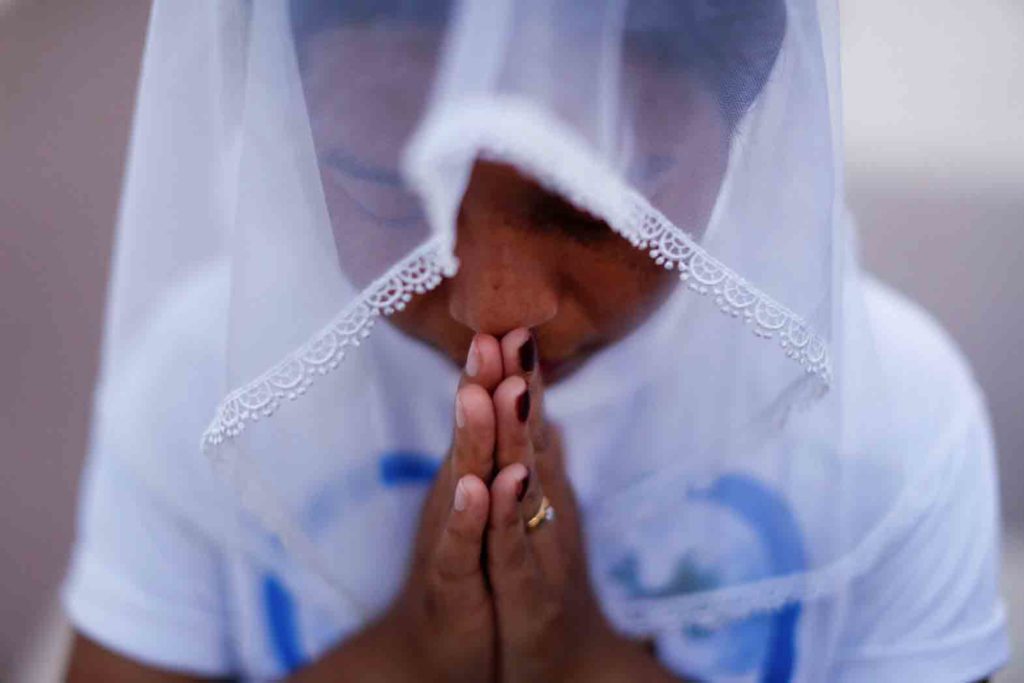The power of prayer

A woman is pictured in a file photo praying at St. Anthony church in Yangon, Myanmar. (CNS photo/Jorge Silva, Reuters)
A priest was summoned by a daughter for her dying father, Mr. J, for a confession. When the daughter left the room, Mr. J’s first confession to the priest was, “I never learned how to pray” although he went to church, hearing pastors talk about prayer that simply went right over his head.
“I abandoned any attempt at prayer; until one day my best friend quipped, ‘J, prayer is simply a matter of conversing with God.’” The friend then asked Mr. J to sit down and, as the latter did, placed an empty chair in front of him. “Now speak to God the way you are speaking with me right now.”
Mr. J probably discovered this ‘cathartic,’ who later admitted to his friend that he had begun practicing a few hours every day. “I have to be ‘cautious’ though. If my daughter caught me talking to myself, she would freak out or send me off to the funny farm,” quipped Mr. J.
The priest mumbly anointed Mr. J with oil and went back to his church.
Catharsis
Catharsis in the jargon of psychoanalytic theory is the discharge of repressed affects connected to traumatic events by bringing these events back into consciousness and reexperiencing or “recalling” (remembering) them.
This is probably the most ponderous, invisible yet foundational plinth — the “gene” — of all the psychodynamic ideas theorized, proposed and expounded by the founding father Dr. Sigmund Freud, quipped an aspiring psycho-bioinformatician kibitzer friend.
However, in contemporary scientific parlance, “catharsis” is defined simply as the release of strong, sometimes pent-up, emotions. Emotion is fundamentally a complex human reaction pattern that involves, triggers and manifests experiential, behavioral, physiological or even pathological minutia.
Dr. P. Ekman, a pioneer in the study of emotion proposed seven basic human behaviors: happiness/enjoyment, sadness, anger, fear, surprise, disgust and contempt.
Significance
Studies show that the specific quality of the emotion, for instance happiness/enjoyment, is determined by the specific significance of the event. This means if the significance involves an “unburdening of guilty feeling” through confession with a priest, unloading feelings to a friend, talking to a therapist, or praying to an empty chair– happiness/enjoyment is likely to be generated.
Empirical studies have repeatedly shown that to confess, to unload feelings and talk or pray, can lead to experiencing a “relief-effect” from such “unburdening.” Unburdening, as many humans will attest, makes one “feel good” and brings a sense of inner happiness/enjoyment. The indigenous term ‘nahimasmasan’ in Tagalog, or ‘mipasmo’ in Kapampangan, comes to mind, quipped the wife and sister of a relative’s kibitzer friend.
This is truly the seminal concept behind confession (religious, criminal or otherwise), and prayer and thousands of variations, including the most arcane or esoteric talk-therapies, added a criminologist kibitzer friend.
The rub is, from Freudian and Jungian complex psychodynamic theorists to contemporary and tech-avant-garde-assisted biopsychosociocultural practitioners, experts are still grappling for the precise scientific reason why the “mere-talk” modality affects every constitution of our existence, quipped my reductionist kibitzer friend.
However, we are reminded that emotion typically involves feeling, but feeling that is different from having an overt or implicit engagement with the world.
Practice
To pray or not to pray is, of course is one’s own prerogative. Only God would know anyway, so you are told.
A former agnostic alter-ego kibitzer friend confided, “You do not need a chair to talk with your God…do it anywhere… anytime… anyway…” This kibitzer friend does his daily communing with God by allotting a certain mile during his five o’clock morning striding (others call it fast-walking or jogging).
In addition to communing while striding, this kibitzer friend also self-talks in prayer; thanking God for even the pettiest of daily occurrences (he calls them blessings). This kibitzer friend of course must hide this from his wife; he does not want her catching him talking to an empty chair, freaking her out and sending him to an asylum.
Science seems to agree with the beneficial effects of prayer. Even politicians seem to agree — President Joe Biden even proclaimed a National Day of Prayer on May 5, 2022, “(calling) upon the citizens of our Nation to give thanks, in accordance with their own faiths and consciences, for our many freedoms and blessings.”
Mr. J died two days after the priest’s visit.
“On that day, my father called upon me with urgency to his bedside, whispered ‘I love you’ and kissed me on the cheek. I left for the store; when I came back my father was gone,” the daughter told the priest.
“I am sure he died peacefully, I am very happy for him,” the daughter assured the priest.
“What do you mean?”
“He died peacefully with a smile on his face… strangely though, I found him leaning over, resting his head on the empty chai rby his bed.”
The priest kept mum as tears rolled down his cheek. Did Mr. J commune and rest his head on God’s lap before dying?
HAPPY THANKSGIVING!
NOTE: The anecdote about Mr. J was adapted from Fr. Bel R. San Luis, SVD article, “The Empty Chair” published on his Manila Bulletin column dated April 29, 2007, which this author kept on file. Dr. Aggie Carson-Arenas is a Certified Clinical Psychology Specialist, a former associate professor and university research director. His latest book is, “You’re Okay, I Am Perfect (How Teens, Adolescents & Those In-Between Quest for Identity)” co-authored by her daughter Abbygale Williamson Arenas-de Leon. docaggie5@yahoo.com.

